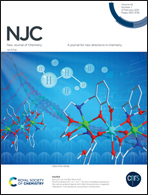New glycine derived peptides bearing benzenesulphonamide as an antiplasmodial agent†
Abstract
In the tropics, malaria is among the most serious infectious diseases in developing countries. The discovery of the artemesinin antimalarial drug not too long ago was a major breakthrough in the effort to combat the malaria disease. However, recent reports of resistance even to combination therapy involving artemisinin are very worrisome and have led to the search for new chemical agents to sustain the fight against malaria. The carboxamide functionality has been shown to be an important pharmacophore in over 25% of commercial chemotherapeutic agents. Three benzensulphonamides (3a–c) were prepared from the reaction of the appropriate benzensulphonyl chloride (1a–c) and alanine (2) in aqueous basic medium. Eight tert-butylamino-oxo-ethylcarbamates (5a–h) were also prepared from reacting commercially available boc-glycine (4) and different amines using peptide coupling reagents such as 1-ethyl-3-(3-dimethylaminopropyl)carbodiimide hydrochloride (EDC) and 1-hydroxybenzotriazole (HOBt), with triethyl amine and dichloromethane (DCM) as solvents. The target compounds were prepared by reacting compounds 3a–c with compounds 5a–h in the presence of coupling reagents to get twenty four (24) different compounds. The compounds were characterized and evaluated for their antiplasmodial activity. Computed molecular descriptors and assessed biochemical parameters showed that the compounds were drug-like and safe. All the compounds had favourable binding interactions with residues at the PABA binding site of homologically modeled P. falciparum dihydropteroate synthase and henceforward the in vitro and in vivo antiplasmodial activities were evaluated. Compounds 7a–7x showed activity against P. falciparum (W2 strain) at MIC values ranging from 3.52 to 0.09 μM. Moreover, seven of the compounds (7c, 7d, 7i, 7j, 7p, 7r and 7s) showed better activity than quinine (MIC = 0.72 μM). In addition, 16 of the 24 compounds were found to clear more than 50 percent of P. berghei (NK-65 strain) from the blood of infected mice at 12 days post-infection. The percentages of parasites cleared by 20 mg kg−1 of the three most effective compounds (7g, 7n and 7r) were 74.98, 74.98 and 74.07, respectively. In conclusion, 7r (MIC 0.71 μM) from this class of glycine derived sulfonamides has the ability to clear 74.07% of P. berghei from blood of infected mice at 20 mg kg−1 and an interesting pharmacokinetic profile (MW = 430.31 Da, HBA = 7, HBD = 3, log P = 2.56, NRB = 9 and TPSA = 104.37 Å2), which is in agreement with the Lipinski rule of 5 for a compound to be qualified as a drug candidate. 7r could serve as a lead in developing new antiplasmodial agents.



 Please wait while we load your content...
Please wait while we load your content...